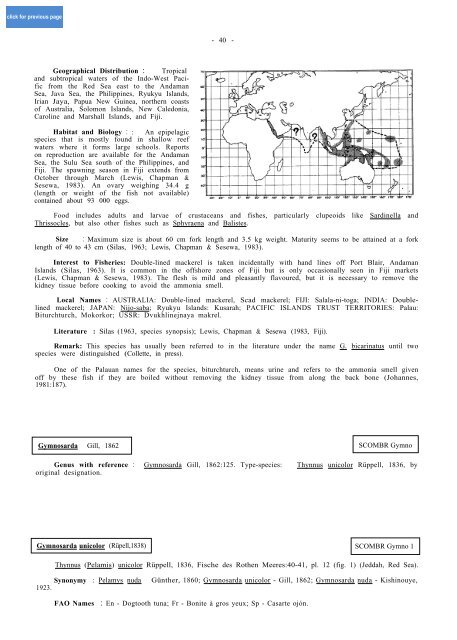FAO SPECIES CATALOGUE - si-pddr
FAO SPECIES CATALOGUE - si-pddr
FAO SPECIES CATALOGUE - si-pddr
Create successful ePaper yourself
Turn your PDF publications into a flip-book with our unique Google optimized e-Paper software.
click for previous page<br />
Geographical Distribution : Tropical<br />
and subtropical waters of the Indo-West Pacific<br />
from the Red Sea east to the Andaman<br />
Sea, Java Sea, the Philippines, Ryukyu Islands,<br />
Irian Jaya, Papua New Guinea, northern coasts<br />
of Australia, Solomon Islands, New Caledonia,<br />
Caroline and Marshall Islands, and Fiji.<br />
Habitat and Biology : : An epipelagic<br />
species that is mostly found in shallow reef<br />
waters where it forms large schools. Reports<br />
on reproduction are available for the Andaman<br />
Sea, the Sulu Sea south of the Philippines, and<br />
Fiji. The spawning season in Fiji extends from<br />
October through March (Lewis, Chapman &<br />
Sesewa, 1983). An ovary weighing 34.4 g<br />
(length or weight of the fish not available)<br />
contained about 93 000 eggs.<br />
- 40 -<br />
Food includes adults and larvae of crustaceans and fishes, particularly clupeoids like Sardinella and<br />
Thrissocles, but also other fishes such as Sphyraena and Balistes.<br />
Size : Maximum <strong>si</strong>ze is about 60 cm fork length and 3.5 kg weight. Maturity seems to be attained at a fork<br />
length of 40 to 43 cm (Silas, 1963; Lewis, Chapman & Sesewa, 1983).<br />
Interest to Fisheries: Double-lined mackerel is taken incidentally with hand lines off Port Blair, Andaman<br />
Islands (Silas, 1963). It is common in the offshore zones of Fiji but is only occa<strong>si</strong>onally seen in Fiji markets<br />
(Lewis, Chapman & Sesewa, 1983). The flesh is mild and pleasantly flavoured, but it is necessary to remove the<br />
kidney tissue before cooking to avoid the ammonia smell.<br />
Local Names : AUSTRALIA: Double-lined mackerel, Scad mackerel; FIJI: Salala-ni-toga; INDIA: Doublelined<br />
mackerel; JAPAN: Nijo-saba; Ryukyu Islands: Kusarah; PACIFIC ISLANDS TRUST TERRITORIES: Palau:<br />
Biturchturch, Mokorkor; USSR: Dvukhlinejnaya makrel.<br />
Literature : Silas (1963, species synop<strong>si</strong>s); Lewis, Chapman & Sesewa (1983, Fiji).<br />
Remark: This species has usually been referred to in the literature under the name G. bicarinatus until two<br />
species were distinguished (Collette, in press).<br />
One of the Palauan names for the species, biturchturch, means urine and refers to the ammonia smell given<br />
off by these fish if they are boiled without removing the kidney tissue from along the back bone (Johannes,<br />
1981:187).<br />
Gymnosarda Gill, 1862<br />
Genus with reference : Gymnosarda Gill, 1862:125. Type-species: Thynnus unicolor Rüppell, 1836, by<br />
original de<strong>si</strong>gnation.<br />
Gymnosarda unicolor (Rüpell,1838)<br />
Thynnus (Pelamis) unicolor Rüppell, 1836, Fische des Rothen Meeres:40-41, pl. 12 (fig. 1) (Jeddah, Red Sea).<br />
Synonymy<br />
1923.<br />
: Pelamys nuda Günther, 1860; Gymnosarda unicolor - Gill, 1862; Gymnosarda nuda - Kishinouye,<br />
<strong>FAO</strong> Names : En - Dogtooth tuna; Fr - Bonite à gros yeux; Sp - Casarte ojón.<br />
SCOMBR Gymno<br />
SCOMBR Gymno 1
















